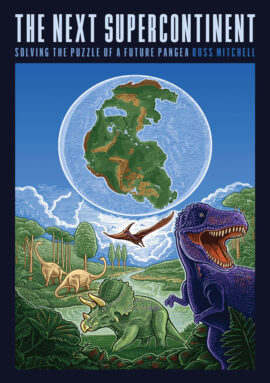‘The Next Supercontinent’ predicts a future collision of North America and Asia
In his new book, Ross Mitchell traces the dance of the continents through time to predict what Amasia, the next supercontinent, might look like.

The Next Supercontinent
Ross Mitchell
Univ. of Chicago, $30
Today, there are seven continents. Some 200 million years from now, there will be just one. In The Next Supercontinent, geophysicist Ross Mitchell previews what the world might look like when Earth’s continents amalgamate into a single landmass.
Although Mitchell’s destination is the distant future, don’t be fooled. His book is as much a romp through the past as it is a look ahead, complete with references unique to the present (like Dwayne “The Rock” Johnson helming a speedboat as it crests a highly improbable tsunami that ravages the Golden Gate Bridge in the movie San Andreas).
On the journey back in time, Mitchell visits how the continents came together in the past to form the previous supercontinents. He begins about 300 million to 200 million years ago with lush, dinosaur-laden Pangaea, which was centered on present-day Africa. He then goes back to a billion years ago to barren Rodinia, whose center consisted of much of today’s North America plus Greenland. Two billion years ago, there was what some scientists call Columbia — the Siberia-centric first supercontinent.
Tracking the paths of today’s continents through history takes some serious scientific sleuthing. This often begins with fieldwork to collect samples that constrain when a rock formed and its latitude at that time. To give readers a taste of such (mis)adventures, Mitchell shares how he lost half his right thumb in the Australian Outback while unearthing some of Rodinia’s mysteries, and when he and a colleague were nearly stranded with their samples on a frigid lake in Canada’s Northwest Territories.
Clues as to why supercontinents form in the first place and what causes their repeated rending also reside in an entirely different field of study — one in which scientists simulate how the “solid but pliable” mantle might have behaved to coax continents along. The mantle regulates the relationship between the crust and Earth’s core, which stores primordial heat. The supercontinent cycle, Mitchell argues, is linked to mantle movement that transfers Earth’s interior heat upward so the crust can release it.
As heat rises, scientists suspect, continents drift toward regions where the mantle is cold. These cold spots exist where oceanic plates subduct, or sink below more buoyant tectonic plates, into the mantle. Inch by inch, subducting ocean will disappear and bring continents closer together, resulting in a collision that will eventually culminate in a new supercontinent. Mantle simulations suggest that after the supersized landmass has formed, the incessant inward pull ceases as new subduction zones initiate at the coastlines of the supercontinent. Somewhere in the interior of the supercontinent, hot mantle rises, eventually causing the supercontinent to tear, forming new oceans and beginning another cycle.
Using the past to predict the future and understanding the mechanics of the mantle, Mitchell presents his vision of Amasia — the next supercontinent (SN: 1/21/17, p. 18). Some researchers have suggested it will form from either the closing of the Pacific or Atlantic oceans. But he posits Amasia will form via the disappearance of the Arctic Ocean as the Americas and Eurasia meet near the North Pole, dragging the other continents along for the ride.
Throughout the book, Mitchell’s clear explanations and carefully chosen images help make sense of even the most complicated concepts (take it from a trained geologist who always had trouble with the particulars of the study of Earth’s past magnetic field — paleomagnetism — which often drive supercontinent reconstructions).
But whether Mitchell’s predictions are correct is something no reader will live long enough to find out, though maybe our descendants will. That will require humankind to survive far longer than any other known mammal. But given all our achievements as a species, Mitchell is hopeful we can beat the odds. “While such longevity may seem far-fetched,” he writes, “doesn’t it also sound a lot like us?”
Buy The Next Supercontinent from Bookshop.org. Science News is a Bookshop.org affiliate and will earn a commission on purchases made from links in this article.
What's Your Reaction?




























































